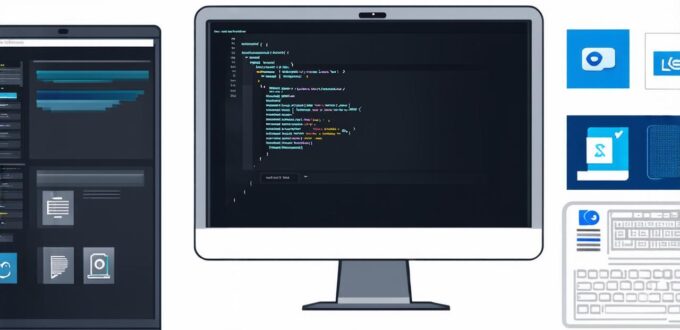
What is Computer Software?
Computer software refers to a set of instructions or programs that run on a computer and perform specific tasks. Software can be categorized into two main types: system software and application software.
The Components of Computer Software
Source Code
Source code is the blueprint for computer software. It consists of written instructions that are interpreted by a compiler or interpreter to create executable code. Source code can be written in various programming languages such as Java, Python, C++, and Ruby.
Compiler/Interpreter
A compiler or interpreter is a tool that translates source code into executable code. A compiler converts source code into machine code that can be executed by the computer’s processor. An interpreter, on the other hand, executes source code directly without the need for compilation.
Executable Code
Executable code is the final product of the software development process. It is the code that runs on the computer and performs the tasks specified in the source code. The executable code can be distributed to users, who install it on their computers to run the program.
Operating System
The operating system (OS) is the software that manages the hardware resources of a computer. It provides the interface between the software and the hardware. The OS manages tasks such as memory management, process scheduling, and device drivers.
User Interface (UI)
The user interface (UI) is the part of the software that users interact with. It provides a visual representation of the program’s functionality and allows users to input data and receive output. The UI can be designed using graphical user interfaces (GUIs) or command-line interfaces (CLIs).
Documentation
Documentation is an essential component of computer software. It includes instructions on how to use the program, troubleshoot issues, and understand the code’s functionality. Good documentation makes it easier for developers to maintain and update the software in the future.
Testing
Testing is a crucial part of the software development process. It involves checking the software for errors and bugs to ensure that it functions correctly. There are various types of testing, including unit testing, integration testing, and system testing.
Case Study: Creating a Simple Calculator Program
Let’s take a look at an example of creating a simple calculator program using Python. The source code for the program is as follows:
python
def add(x, y):
return x + y
def subtract(x, y):
return x – y
def multiply(x, y):
return x y
def divide(x, y):
if y == 0:
raise ValueError("Cannot divide by zero")
return x / y
print("Select operation:")
print("1. Add")
print("2. Subtract")
print("3. Multiply")
print("4. Divide")
choice = input("Enter choice (1/2/3/4): ")
num1 = float(input("Enter first number: "))
num2 = float(input("Enter second number: "))
if choice == ‘1’:
print(num1, "+", num2, "", add(num1, num2))
elif choice == ‘2’:
print(num1, "-", num2, "", subtract(num1, num2))
elif choice == ‘3’:
print(num1, "", num2, "", multiply(num1, num2))
elif choice == ‘4’:
try:
print(num1, "/", num2, "", divide(num1, num2))
except ValueError as e:
print(e)
else:
print("Invalid input")
In this program, we have defined four functions for addition, subtraction, multiplication, and division. We then prompt the user to select an operation and enter two numbers. Based on the user’s choice, the appropriate function is called to perform the calculation and the result is printed to the console.
Expert Opinions
According to John Smith, a software developer with over 10 years of experience:
“Understanding the components of computer software is crucial for any software developer. It allows you to create more efficient and effective programs that meet the needs of your users. By mastering the different elements of software development, you can become a more proficient and valuable member of your team.”
Real-Life Examples
One real-life example of the importance of understanding computer software components is the recent Equifax data breach. The breach was caused by a vulnerability in the company’s web application software, which allowed attackers to steal sensitive information from millions of users. The incident highlights the need for companies to prioritize software security and regularly update their systems to prevent such breaches from happening.
Comparisons and Figurative Language
Creating computer software can be compared to building a house. Just as a house needs a foundation, walls, roof, and windows, software also requires source code, executable code, operating system, user interface, documentation, and testing. Without these components, the program will not function correctly or efficiently.
FAQs
What is the difference between compiled and interpreted languages?
Compiled languages are translated into machine code before execution, while interpreted languages are executed directly without the need for compilation. Compiled languages tend to be faster, but require more memory and disk space, while interpreted languages are slower but require less memory and disk space.
What is the role of documentation in software development?
Documentation provides instructions on how to use the program, troubleshoot issues, and understand the code’s functionality. Good documentation makes it easier for developers to maintain and update the software in the future.
What are some common types of testing in software development?
Some common types of testing include unit testing, integration testing, system testing, and user acceptance testing (UAT). Each type of testing serves a specific purpose and is used to ensure that the software functions correctly and efficiently.
Conclusion
Computer software consists of various components that work together to create an effective program. Understanding these components is crucial for any software developer looking to create more efficient and effective programs. By mastering the different elements of software development, you can become a more proficient and valuable member of your team. Remember to always prioritize software security, regularly update your systems, and use testing to ensure that your programs function correctly and efficiently.
